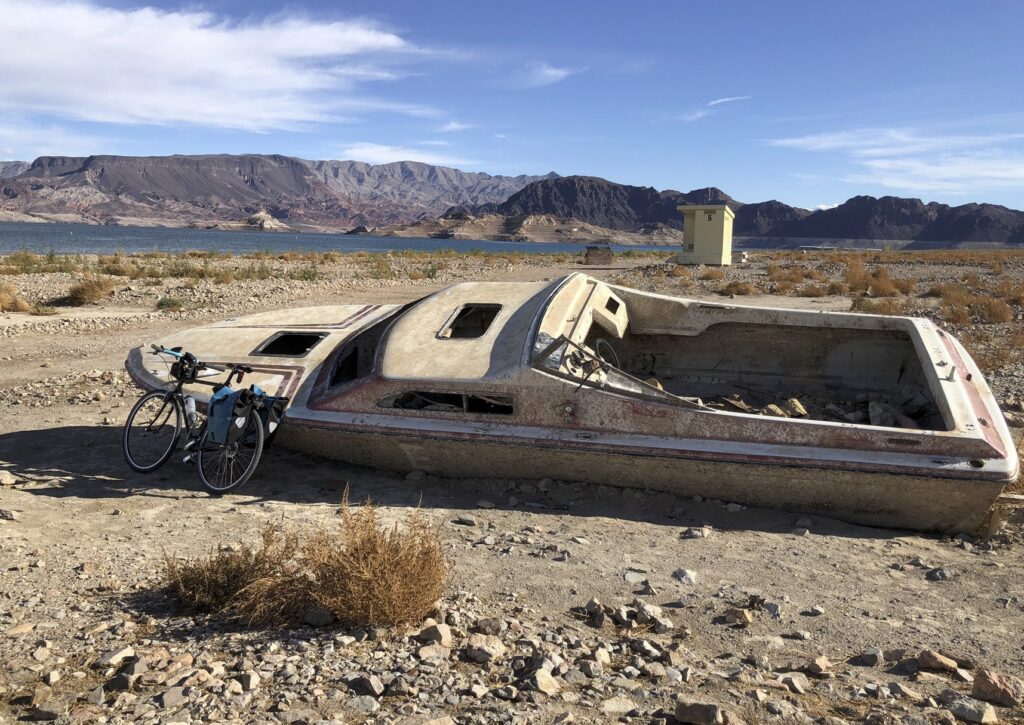
I hope someone’s keeping track of the re-submergence of the Lake Mead shipwrecks.
Lake Mead ended May 2023 at elevation 1,054.28 feet above sea level. That’s up five feet in a month, at a time of year when the reservoir is usually dropping, so I guess yay? It’s also up 6 1/2 feet from last year, so I guess yay?
But also worth noting: Mead is down 32 feet from May of 2019, the year the oddly-named “Drought Contingency Plan” was signed. I say “oddly named” because the clear outcome here suggests that our plan for the contingency of drought must have been to drain Lake Mead.
2023 water use forecast
We’re far enough into the year that we can get a pretty good feel for how deeply Lower Basin water users are cutting in response to the current crisis.
Total cuts from the states’ base allocations are 1.079 million acre feet, which is less than the 1.2 million acre feet in Reclamation’s classic “Structural Deficit” calculation, and well below the 1.5 million or more – a 20 percent reduction – that’s been widely discussed as the need in a climate-change altered Colorado River Basin.
Here’s how the cuts are being made in 2023:
- California: 4.178 million acre feet, a 5 percent reduction from California’s base allocation
- Arizona: 2.031 million acre feet, a 27 percent reduction from Arizona’s base allocation
- Nevada: 212,000 acre feet, a 29 percent reduction from Nevada’s base allocation
Those numbers are forecasts for calendar year 2023, based on Reclamation’s June 2 analysis.
We can argue over whether this is “fair” – I’ve made my case here – but the reality is that Arizona and Nevada right now are contributing disproportionately to the cuts needed to save Lake Mead.
A big part of the reductions for 2023 are based on the requirements of the 2007 Interim Guidelines and the Drought Contingency Plan. (Puzzled over why Arizona and Nevada have to make cuts under the ’07/DCP and California doesn’t? California’s power politics in the 1960s gave it higher priority rights.)
In response to the near term crisis on the river, California is taking an additional 5 percent in cuts this year beyond the ’07/DCP requirements, Arizona is taking 6 percent, and Nevada is taking 24 percent.
| state | base allocation | 2023 | 2023 reduction | percent cut from base | 07/DCP | Cut beyond ’07/DCP |
| California | 4,400,000 | 4,178,000 | 222,000 | 5% | 0 | 5% |
| Arizona | 2,800,000 | 2,031,000 | 769,000 | 27% | 592,000 | 6% |
| Nevada | 300,000 | 212,000 | 88,000 | 29% | 17,000 | 24% |
End of year forecast
The latest Reclamation 24-month study has Mead ending calendar 2023 at elevation 1,062.32.
Despite this year’s monster snowpack and the gazillions of federal dollars currently chasing water use reductions, that’s still down 28 feet since the end of 2019, the year the DCP was signed.
Thanks
A big thanks to my supporters – Inkstain will always be free, your help makes it possible.

Often missing in the conversation about AZ water reduction is this: People forget that AZ refused to sign the original compact. Their reluctance led to a delay in the original implementation, and came close to killing it. AZ then used the courts multiple times all the way into the 1960’s. They did eventually sign, and got additional water rights, but separate from the compact. So the deal was they got more water, but lower priority rights.
So it is easy to feel bad for AZ, but this is something that they agreed to in the 1960’s in order to get the CAP built and water for it. Not really “CA power politics” but more AZ water politics over the last 100 years.
I’m so glad AZ and CA are now working collectively on the lower basin water sharing. I have hope for lower basin comity, which was the original intent of the compact.
That boat is totally fixable.
These “cuts” do not in fact mean that anyone who wants to use their normal amount of water will be involuntarily shorted. Thanks to actions taken by their states, all lower basin users can and will use as much water as they want. It won’t be until there are real reductions to existing uses that the states will feel the pain.